MITS5003 Case Study: Wireless Networks & Communication at MaffraStock
VerifiedAdded on 2023/06/11
|12
|2427
|445
Case Study
AI Summary
This document presents a case study focusing on the implementation of a Wireless Sensor Network (WSN) at MaffraStock farm, a livestock operation in Gippsland. The study explores the selection of appropriate frequency bands for WSN, calculating channel capacity and noise levels, determining signal power and bandwidth requirements, and assessing free space loss. It further addresses the required transmission signal strength considering signal impairments. The document also suggests functionalities for a cloud application leveraging sensor data in the agriculture sector and discusses how IoT platforms can aid in WSN implementation, highlighting the roles of WiFi, Bluetooth, and mobile phone technologies in facilitating data transfer and network connectivity. The analysis incorporates calculations based on provided parameters and relevant formulas to optimize WSN performance for animal health and behavior monitoring at MaffraStock farm.
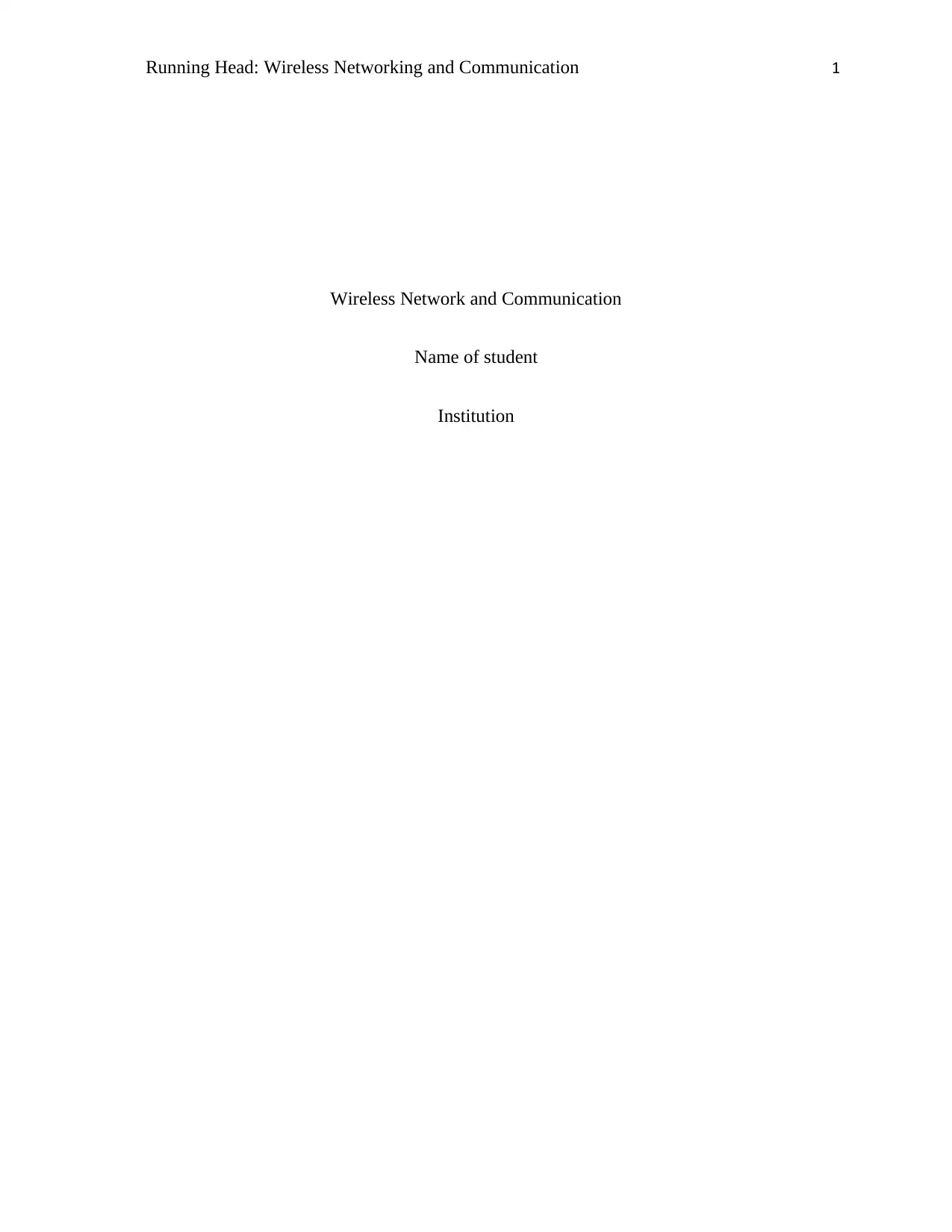
Running Head: Wireless Networking and Communication 1
Wireless Network and Communication
Name of student
Institution
Wireless Network and Communication
Name of student
Institution
Paraphrase This Document
Need a fresh take? Get an instant paraphrase of this document with our AI Paraphraser
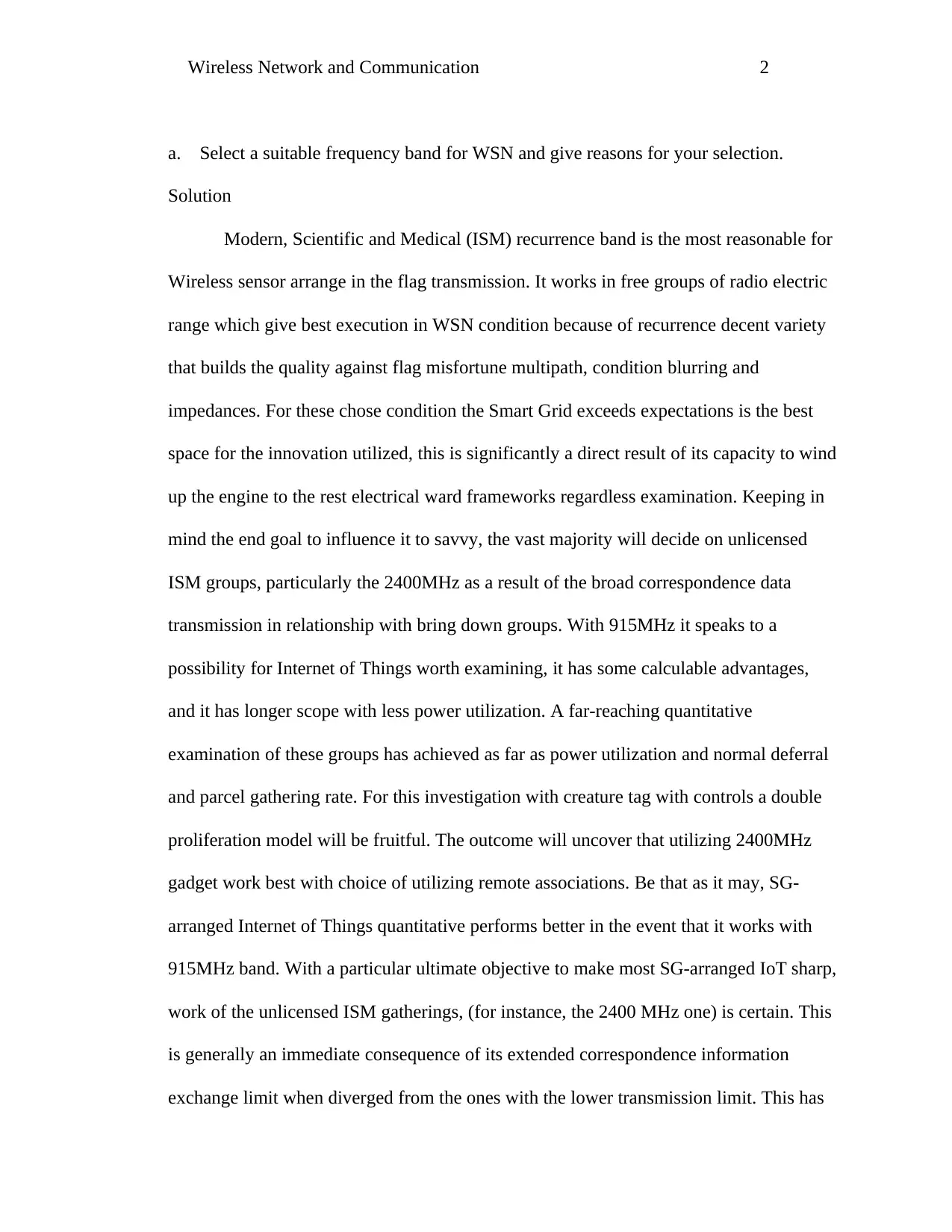
Wireless Network and Communication 2
a. Select a suitable frequency band for WSN and give reasons for your selection.
Solution
Modern, Scientific and Medical (ISM) recurrence band is the most reasonable for
Wireless sensor arrange in the flag transmission. It works in free groups of radio electric
range which give best execution in WSN condition because of recurrence decent variety
that builds the quality against flag misfortune multipath, condition blurring and
impedances. For these chose condition the Smart Grid exceeds expectations is the best
space for the innovation utilized, this is significantly a direct result of its capacity to wind
up the engine to the rest electrical ward frameworks regardless examination. Keeping in
mind the end goal to influence it to savvy, the vast majority will decide on unlicensed
ISM groups, particularly the 2400MHz as a result of the broad correspondence data
transmission in relationship with bring down groups. With 915MHz it speaks to a
possibility for Internet of Things worth examining, it has some calculable advantages,
and it has longer scope with less power utilization. A far-reaching quantitative
examination of these groups has achieved as far as power utilization and normal deferral
and parcel gathering rate. For this investigation with creature tag with controls a double
proliferation model will be fruitful. The outcome will uncover that utilizing 2400MHz
gadget work best with choice of utilizing remote associations. Be that as it may, SG-
arranged Internet of Things quantitative performs better in the event that it works with
915MHz band. With a particular ultimate objective to make most SG-arranged IoT sharp,
work of the unlicensed ISM gatherings, (for instance, the 2400 MHz one) is certain. This
is generally an immediate consequence of its extended correspondence information
exchange limit when diverged from the ones with the lower transmission limit. This has
a. Select a suitable frequency band for WSN and give reasons for your selection.
Solution
Modern, Scientific and Medical (ISM) recurrence band is the most reasonable for
Wireless sensor arrange in the flag transmission. It works in free groups of radio electric
range which give best execution in WSN condition because of recurrence decent variety
that builds the quality against flag misfortune multipath, condition blurring and
impedances. For these chose condition the Smart Grid exceeds expectations is the best
space for the innovation utilized, this is significantly a direct result of its capacity to wind
up the engine to the rest electrical ward frameworks regardless examination. Keeping in
mind the end goal to influence it to savvy, the vast majority will decide on unlicensed
ISM groups, particularly the 2400MHz as a result of the broad correspondence data
transmission in relationship with bring down groups. With 915MHz it speaks to a
possibility for Internet of Things worth examining, it has some calculable advantages,
and it has longer scope with less power utilization. A far-reaching quantitative
examination of these groups has achieved as far as power utilization and normal deferral
and parcel gathering rate. For this investigation with creature tag with controls a double
proliferation model will be fruitful. The outcome will uncover that utilizing 2400MHz
gadget work best with choice of utilizing remote associations. Be that as it may, SG-
arranged Internet of Things quantitative performs better in the event that it works with
915MHz band. With a particular ultimate objective to make most SG-arranged IoT sharp,
work of the unlicensed ISM gatherings, (for instance, the 2400 MHz one) is certain. This
is generally an immediate consequence of its extended correspondence information
exchange limit when diverged from the ones with the lower transmission limit. This has
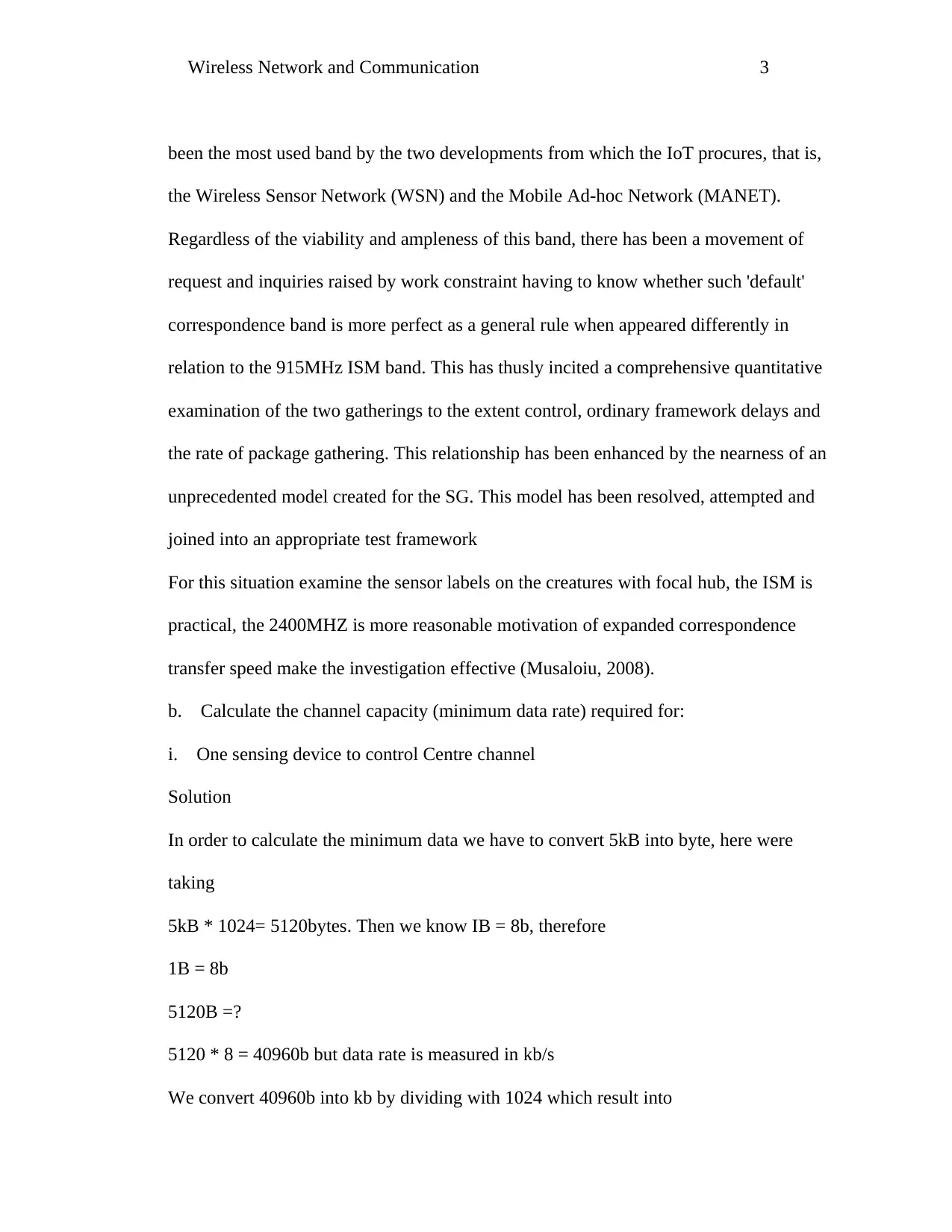
Wireless Network and Communication 3
been the most used band by the two developments from which the IoT procures, that is,
the Wireless Sensor Network (WSN) and the Mobile Ad-hoc Network (MANET).
Regardless of the viability and ampleness of this band, there has been a movement of
request and inquiries raised by work constraint having to know whether such 'default'
correspondence band is more perfect as a general rule when appeared differently in
relation to the 915MHz ISM band. This has thusly incited a comprehensive quantitative
examination of the two gatherings to the extent control, ordinary framework delays and
the rate of package gathering. This relationship has been enhanced by the nearness of an
unprecedented model created for the SG. This model has been resolved, attempted and
joined into an appropriate test framework
For this situation examine the sensor labels on the creatures with focal hub, the ISM is
practical, the 2400MHZ is more reasonable motivation of expanded correspondence
transfer speed make the investigation effective (Musaloiu, 2008).
b. Calculate the channel capacity (minimum data rate) required for:
i. One sensing device to control Centre channel
Solution
In order to calculate the minimum data we have to convert 5kB into byte, here were
taking
5kB * 1024= 5120bytes. Then we know IB = 8b, therefore
1B = 8b
5120B =?
5120 * 8 = 40960b but data rate is measured in kb/s
We convert 40960b into kb by dividing with 1024 which result into
been the most used band by the two developments from which the IoT procures, that is,
the Wireless Sensor Network (WSN) and the Mobile Ad-hoc Network (MANET).
Regardless of the viability and ampleness of this band, there has been a movement of
request and inquiries raised by work constraint having to know whether such 'default'
correspondence band is more perfect as a general rule when appeared differently in
relation to the 915MHz ISM band. This has thusly incited a comprehensive quantitative
examination of the two gatherings to the extent control, ordinary framework delays and
the rate of package gathering. This relationship has been enhanced by the nearness of an
unprecedented model created for the SG. This model has been resolved, attempted and
joined into an appropriate test framework
For this situation examine the sensor labels on the creatures with focal hub, the ISM is
practical, the 2400MHZ is more reasonable motivation of expanded correspondence
transfer speed make the investigation effective (Musaloiu, 2008).
b. Calculate the channel capacity (minimum data rate) required for:
i. One sensing device to control Centre channel
Solution
In order to calculate the minimum data we have to convert 5kB into byte, here were
taking
5kB * 1024= 5120bytes. Then we know IB = 8b, therefore
1B = 8b
5120B =?
5120 * 8 = 40960b but data rate is measured in kb/s
We convert 40960b into kb by dividing with 1024 which result into
⊘ This is a preview!⊘
Do you want full access?
Subscribe today to unlock all pages.

Trusted by 1+ million students worldwide
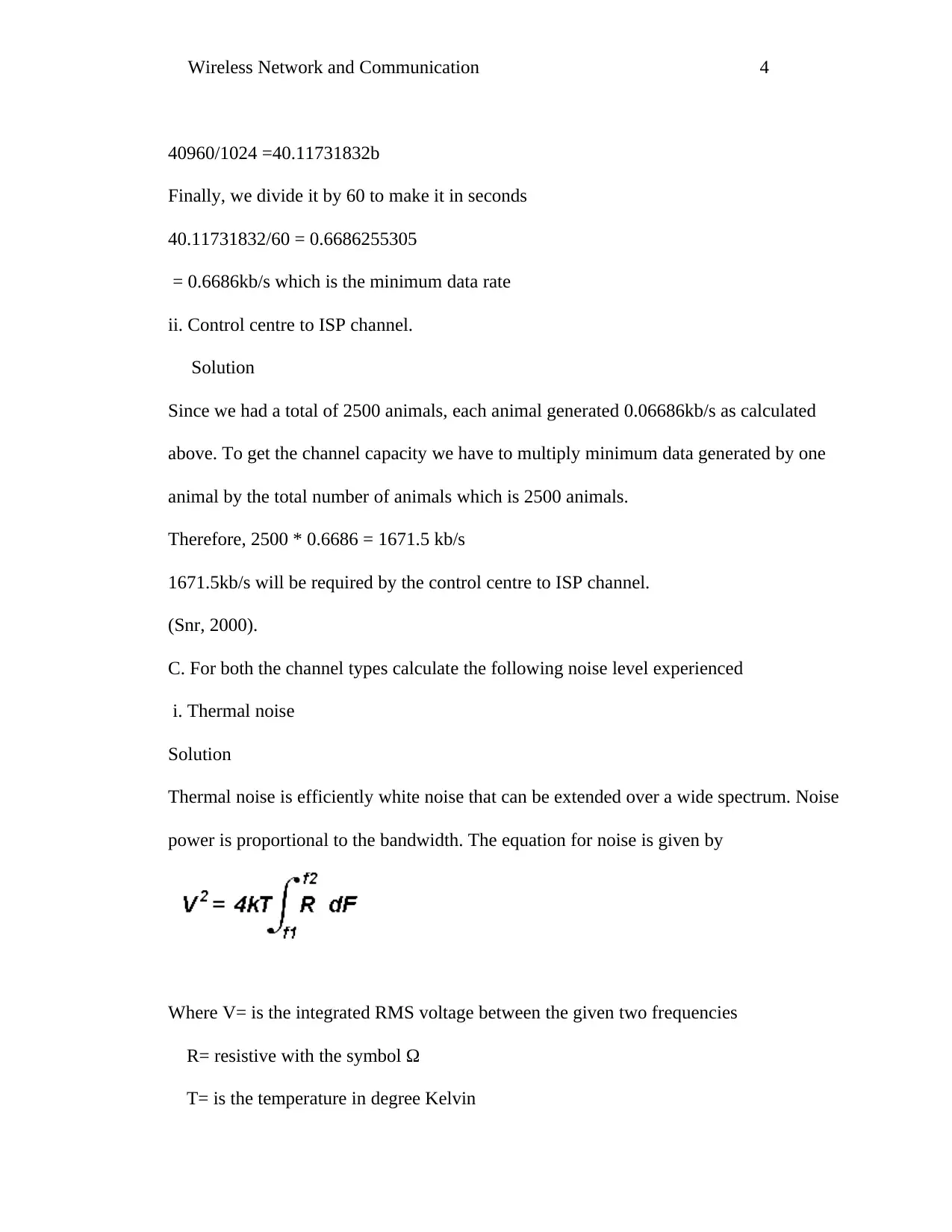
Wireless Network and Communication 4
40960/1024 =40.11731832b
Finally, we divide it by 60 to make it in seconds
40.11731832/60 = 0.6686255305
= 0.6686kb/s which is the minimum data rate
ii. Control centre to ISP channel.
Solution
Since we had a total of 2500 animals, each animal generated 0.06686kb/s as calculated
above. To get the channel capacity we have to multiply minimum data generated by one
animal by the total number of animals which is 2500 animals.
Therefore, 2500 * 0.6686 = 1671.5 kb/s
1671.5kb/s will be required by the control centre to ISP channel.
(Snr, 2000).
C. For both the channel types calculate the following noise level experienced
i. Thermal noise
Solution
Thermal noise is efficiently white noise that can be extended over a wide spectrum. Noise
power is proportional to the bandwidth. The equation for noise is given by
Where V= is the integrated RMS voltage between the given two frequencies
R= resistive with the symbol Ω
T= is the temperature in degree Kelvin
40960/1024 =40.11731832b
Finally, we divide it by 60 to make it in seconds
40.11731832/60 = 0.6686255305
= 0.6686kb/s which is the minimum data rate
ii. Control centre to ISP channel.
Solution
Since we had a total of 2500 animals, each animal generated 0.06686kb/s as calculated
above. To get the channel capacity we have to multiply minimum data generated by one
animal by the total number of animals which is 2500 animals.
Therefore, 2500 * 0.6686 = 1671.5 kb/s
1671.5kb/s will be required by the control centre to ISP channel.
(Snr, 2000).
C. For both the channel types calculate the following noise level experienced
i. Thermal noise
Solution
Thermal noise is efficiently white noise that can be extended over a wide spectrum. Noise
power is proportional to the bandwidth. The equation for noise is given by
Where V= is the integrated RMS voltage between the given two frequencies
R= resistive with the symbol Ω
T= is the temperature in degree Kelvin
Paraphrase This Document
Need a fresh take? Get an instant paraphrase of this document with our AI Paraphraser
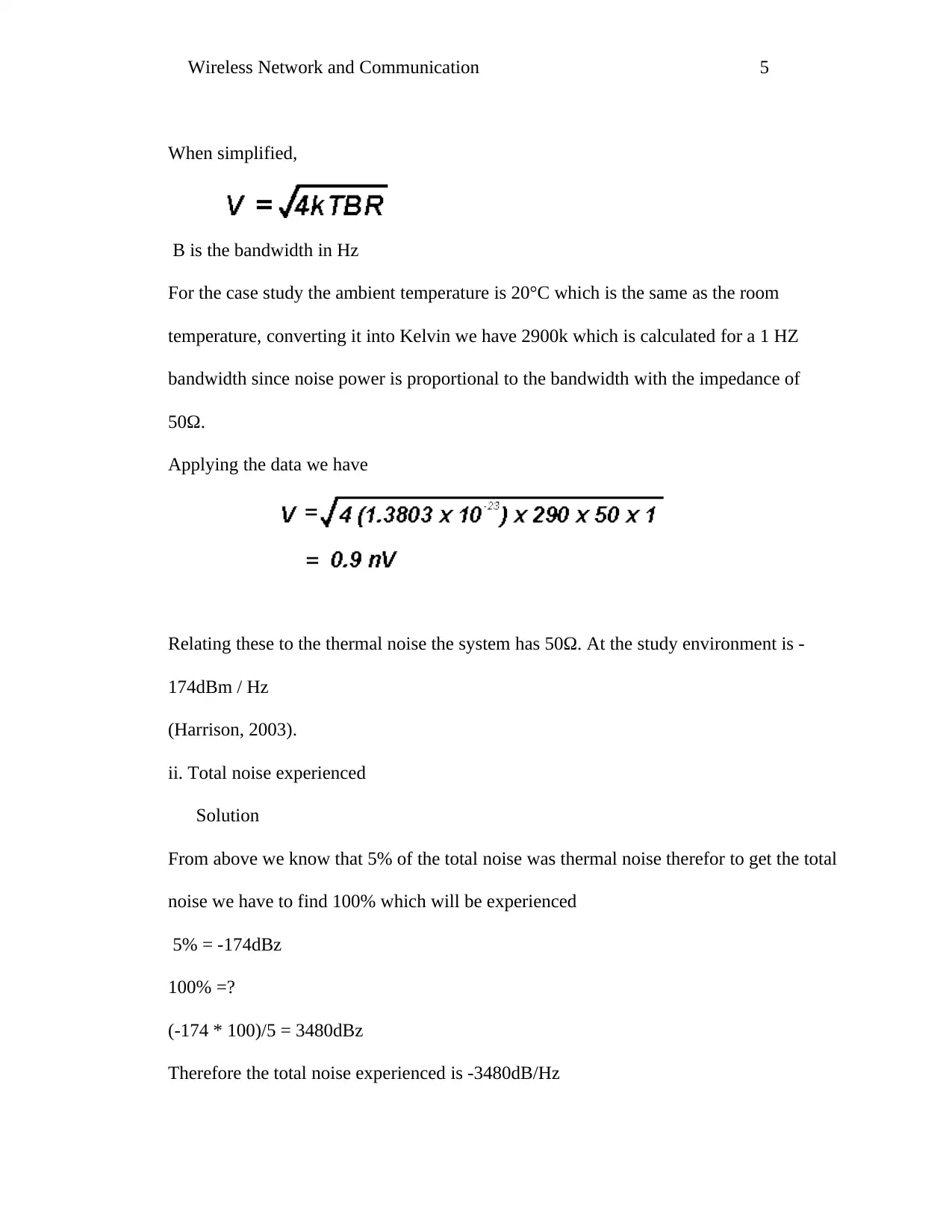
Wireless Network and Communication 5
When simplified,
B is the bandwidth in Hz
For the case study the ambient temperature is 20°C which is the same as the room
temperature, converting it into Kelvin we have 2900k which is calculated for a 1 HZ
bandwidth since noise power is proportional to the bandwidth with the impedance of
50Ω.
Applying the data we have
Relating these to the thermal noise the system has 50Ω. At the study environment is -
174dBm / Hz
(Harrison, 2003).
ii. Total noise experienced
Solution
From above we know that 5% of the total noise was thermal noise therefor to get the total
noise we have to find 100% which will be experienced
5% = -174dBz
100% =?
(-174 * 100)/5 = 3480dBz
Therefore the total noise experienced is -3480dB/Hz
When simplified,
B is the bandwidth in Hz
For the case study the ambient temperature is 20°C which is the same as the room
temperature, converting it into Kelvin we have 2900k which is calculated for a 1 HZ
bandwidth since noise power is proportional to the bandwidth with the impedance of
50Ω.
Applying the data we have
Relating these to the thermal noise the system has 50Ω. At the study environment is -
174dBm / Hz
(Harrison, 2003).
ii. Total noise experienced
Solution
From above we know that 5% of the total noise was thermal noise therefor to get the total
noise we have to find 100% which will be experienced
5% = -174dBz
100% =?
(-174 * 100)/5 = 3480dBz
Therefore the total noise experienced is -3480dB/Hz
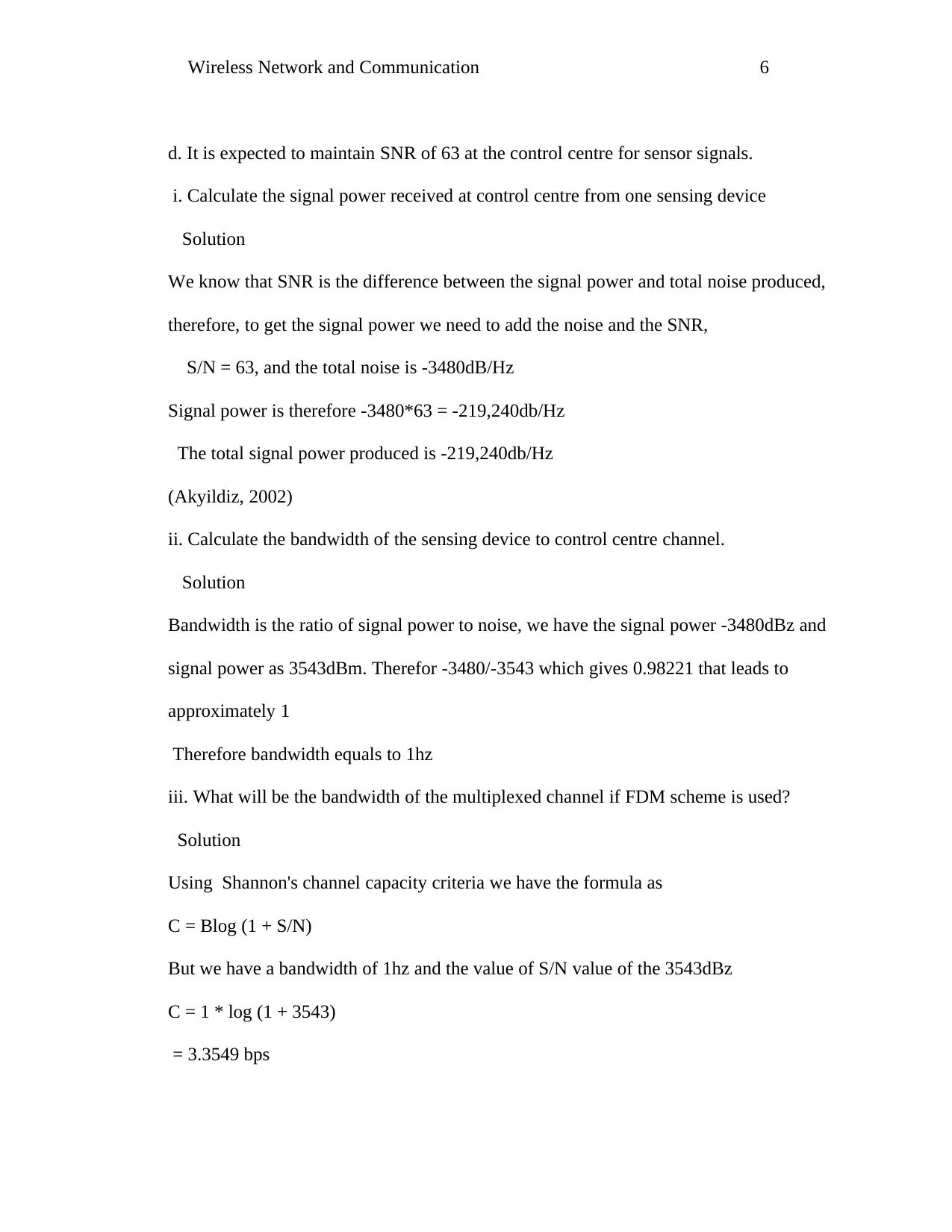
Wireless Network and Communication 6
d. It is expected to maintain SNR of 63 at the control centre for sensor signals.
i. Calculate the signal power received at control centre from one sensing device
Solution
We know that SNR is the difference between the signal power and total noise produced,
therefore, to get the signal power we need to add the noise and the SNR,
S/N = 63, and the total noise is -3480dB/Hz
Signal power is therefore -3480*63 = -219,240db/Hz
The total signal power produced is -219,240db/Hz
(Akyildiz, 2002)
ii. Calculate the bandwidth of the sensing device to control centre channel.
Solution
Bandwidth is the ratio of signal power to noise, we have the signal power -3480dBz and
signal power as 3543dBm. Therefor -3480/-3543 which gives 0.98221 that leads to
approximately 1
Therefore bandwidth equals to 1hz
iii. What will be the bandwidth of the multiplexed channel if FDM scheme is used?
Solution
Using Shannon's channel capacity criteria we have the formula as
C = Blog (1 + S/N)
But we have a bandwidth of 1hz and the value of S/N value of the 3543dBz
C = 1 * log (1 + 3543)
= 3.3549 bps
d. It is expected to maintain SNR of 63 at the control centre for sensor signals.
i. Calculate the signal power received at control centre from one sensing device
Solution
We know that SNR is the difference between the signal power and total noise produced,
therefore, to get the signal power we need to add the noise and the SNR,
S/N = 63, and the total noise is -3480dB/Hz
Signal power is therefore -3480*63 = -219,240db/Hz
The total signal power produced is -219,240db/Hz
(Akyildiz, 2002)
ii. Calculate the bandwidth of the sensing device to control centre channel.
Solution
Bandwidth is the ratio of signal power to noise, we have the signal power -3480dBz and
signal power as 3543dBm. Therefor -3480/-3543 which gives 0.98221 that leads to
approximately 1
Therefore bandwidth equals to 1hz
iii. What will be the bandwidth of the multiplexed channel if FDM scheme is used?
Solution
Using Shannon's channel capacity criteria we have the formula as
C = Blog (1 + S/N)
But we have a bandwidth of 1hz and the value of S/N value of the 3543dBz
C = 1 * log (1 + 3543)
= 3.3549 bps
⊘ This is a preview!⊘
Do you want full access?
Subscribe today to unlock all pages.

Trusted by 1+ million students worldwide
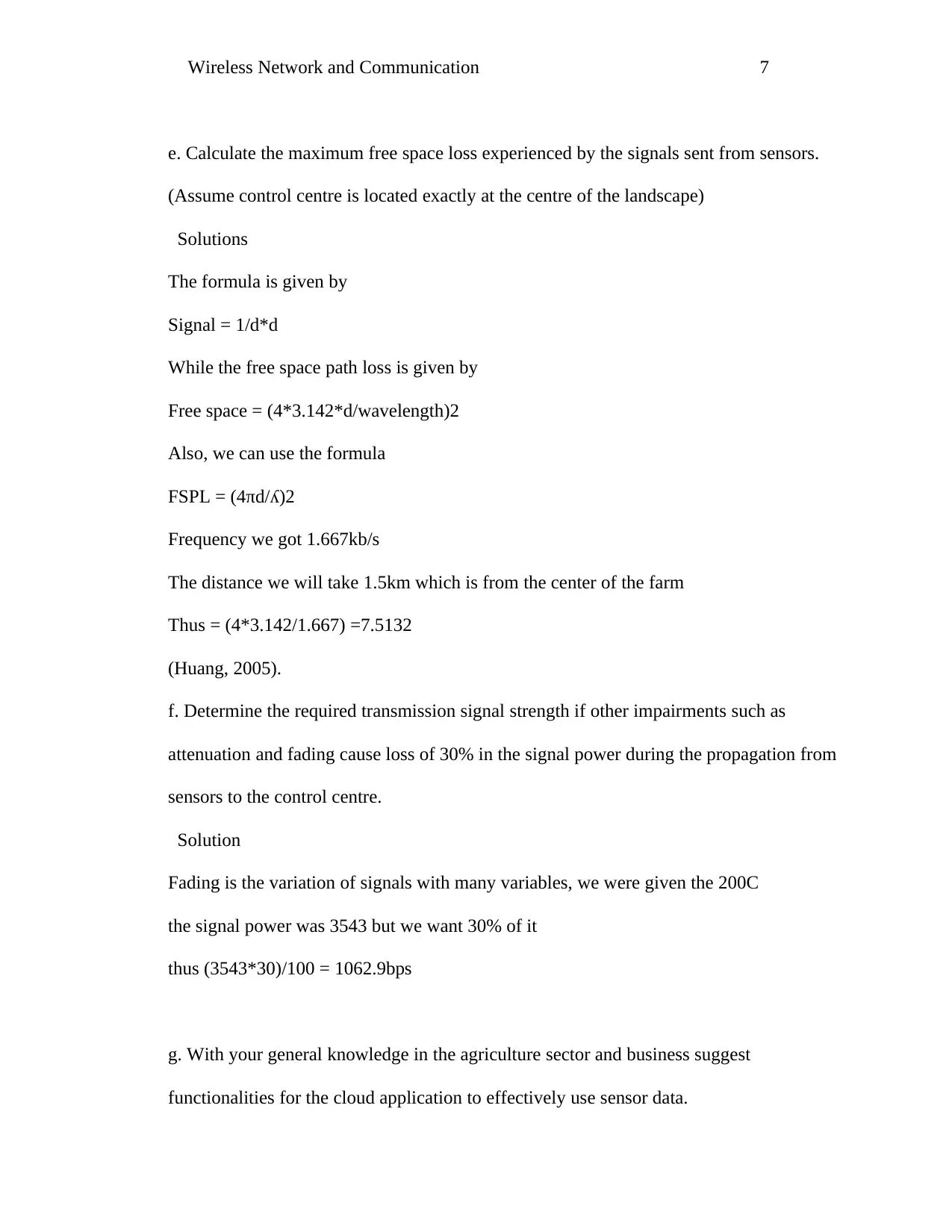
Wireless Network and Communication 7
e. Calculate the maximum free space loss experienced by the signals sent from sensors.
(Assume control centre is located exactly at the centre of the landscape)
Solutions
The formula is given by
Signal = 1/d*d
While the free space path loss is given by
Free space = (4*3.142*d/wavelength)2
Also, we can use the formula
FSPL = (4πd/ʎ)2
Frequency we got 1.667kb/s
The distance we will take 1.5km which is from the center of the farm
Thus = (4*3.142/1.667) =7.5132
(Huang, 2005).
f. Determine the required transmission signal strength if other impairments such as
attenuation and fading cause loss of 30% in the signal power during the propagation from
sensors to the control centre.
Solution
Fading is the variation of signals with many variables, we were given the 200C
the signal power was 3543 but we want 30% of it
thus (3543*30)/100 = 1062.9bps
g. With your general knowledge in the agriculture sector and business suggest
functionalities for the cloud application to effectively use sensor data.
e. Calculate the maximum free space loss experienced by the signals sent from sensors.
(Assume control centre is located exactly at the centre of the landscape)
Solutions
The formula is given by
Signal = 1/d*d
While the free space path loss is given by
Free space = (4*3.142*d/wavelength)2
Also, we can use the formula
FSPL = (4πd/ʎ)2
Frequency we got 1.667kb/s
The distance we will take 1.5km which is from the center of the farm
Thus = (4*3.142/1.667) =7.5132
(Huang, 2005).
f. Determine the required transmission signal strength if other impairments such as
attenuation and fading cause loss of 30% in the signal power during the propagation from
sensors to the control centre.
Solution
Fading is the variation of signals with many variables, we were given the 200C
the signal power was 3543 but we want 30% of it
thus (3543*30)/100 = 1062.9bps
g. With your general knowledge in the agriculture sector and business suggest
functionalities for the cloud application to effectively use sensor data.
Paraphrase This Document
Need a fresh take? Get an instant paraphrase of this document with our AI Paraphraser
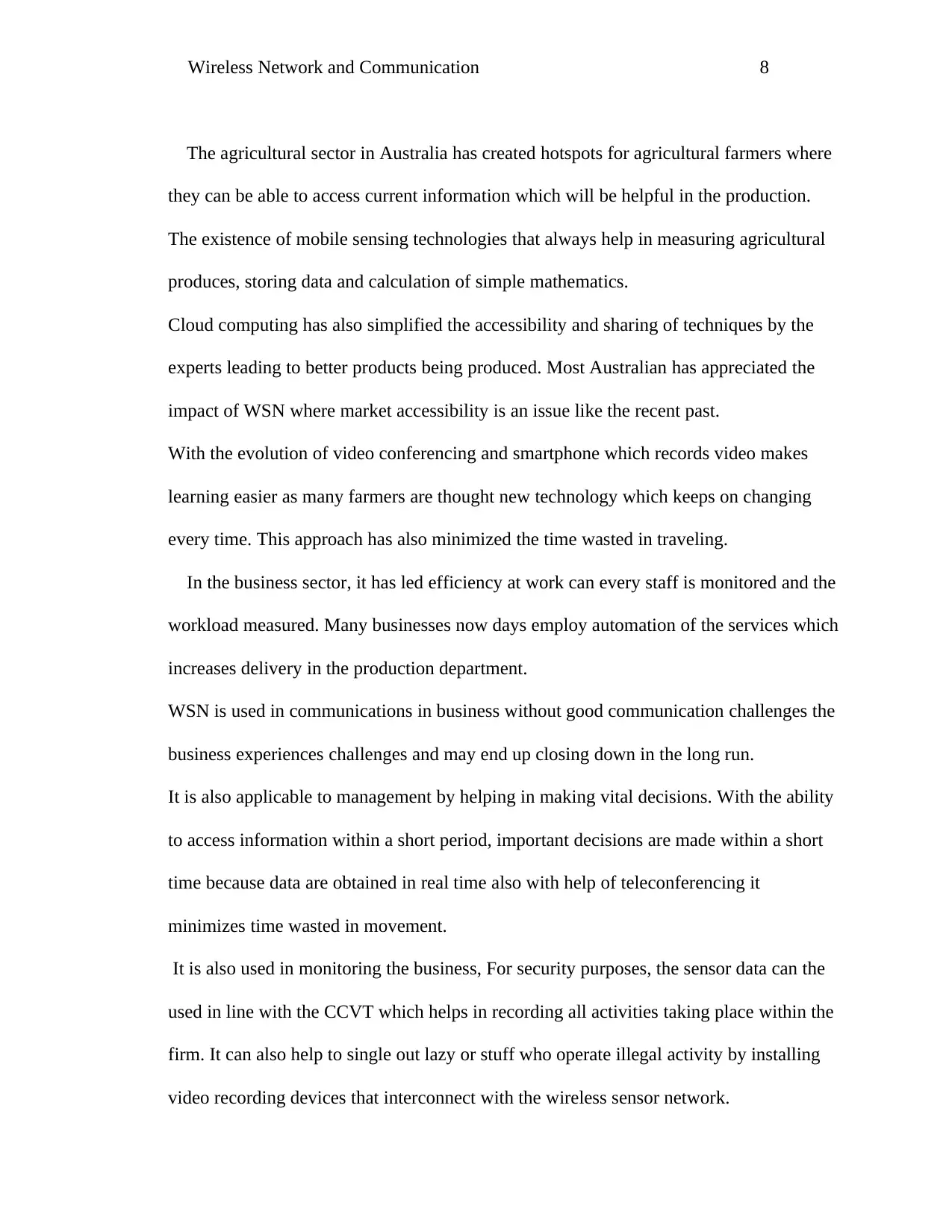
Wireless Network and Communication 8
The agricultural sector in Australia has created hotspots for agricultural farmers where
they can be able to access current information which will be helpful in the production.
The existence of mobile sensing technologies that always help in measuring agricultural
produces, storing data and calculation of simple mathematics.
Cloud computing has also simplified the accessibility and sharing of techniques by the
experts leading to better products being produced. Most Australian has appreciated the
impact of WSN where market accessibility is an issue like the recent past.
With the evolution of video conferencing and smartphone which records video makes
learning easier as many farmers are thought new technology which keeps on changing
every time. This approach has also minimized the time wasted in traveling.
In the business sector, it has led efficiency at work can every staff is monitored and the
workload measured. Many businesses now days employ automation of the services which
increases delivery in the production department.
WSN is used in communications in business without good communication challenges the
business experiences challenges and may end up closing down in the long run.
It is also applicable to management by helping in making vital decisions. With the ability
to access information within a short period, important decisions are made within a short
time because data are obtained in real time also with help of teleconferencing it
minimizes time wasted in movement.
It is also used in monitoring the business, For security purposes, the sensor data can the
used in line with the CCVT which helps in recording all activities taking place within the
firm. It can also help to single out lazy or stuff who operate illegal activity by installing
video recording devices that interconnect with the wireless sensor network.
The agricultural sector in Australia has created hotspots for agricultural farmers where
they can be able to access current information which will be helpful in the production.
The existence of mobile sensing technologies that always help in measuring agricultural
produces, storing data and calculation of simple mathematics.
Cloud computing has also simplified the accessibility and sharing of techniques by the
experts leading to better products being produced. Most Australian has appreciated the
impact of WSN where market accessibility is an issue like the recent past.
With the evolution of video conferencing and smartphone which records video makes
learning easier as many farmers are thought new technology which keeps on changing
every time. This approach has also minimized the time wasted in traveling.
In the business sector, it has led efficiency at work can every staff is monitored and the
workload measured. Many businesses now days employ automation of the services which
increases delivery in the production department.
WSN is used in communications in business without good communication challenges the
business experiences challenges and may end up closing down in the long run.
It is also applicable to management by helping in making vital decisions. With the ability
to access information within a short period, important decisions are made within a short
time because data are obtained in real time also with help of teleconferencing it
minimizes time wasted in movement.
It is also used in monitoring the business, For security purposes, the sensor data can the
used in line with the CCVT which helps in recording all activities taking place within the
firm. It can also help to single out lazy or stuff who operate illegal activity by installing
video recording devices that interconnect with the wireless sensor network.
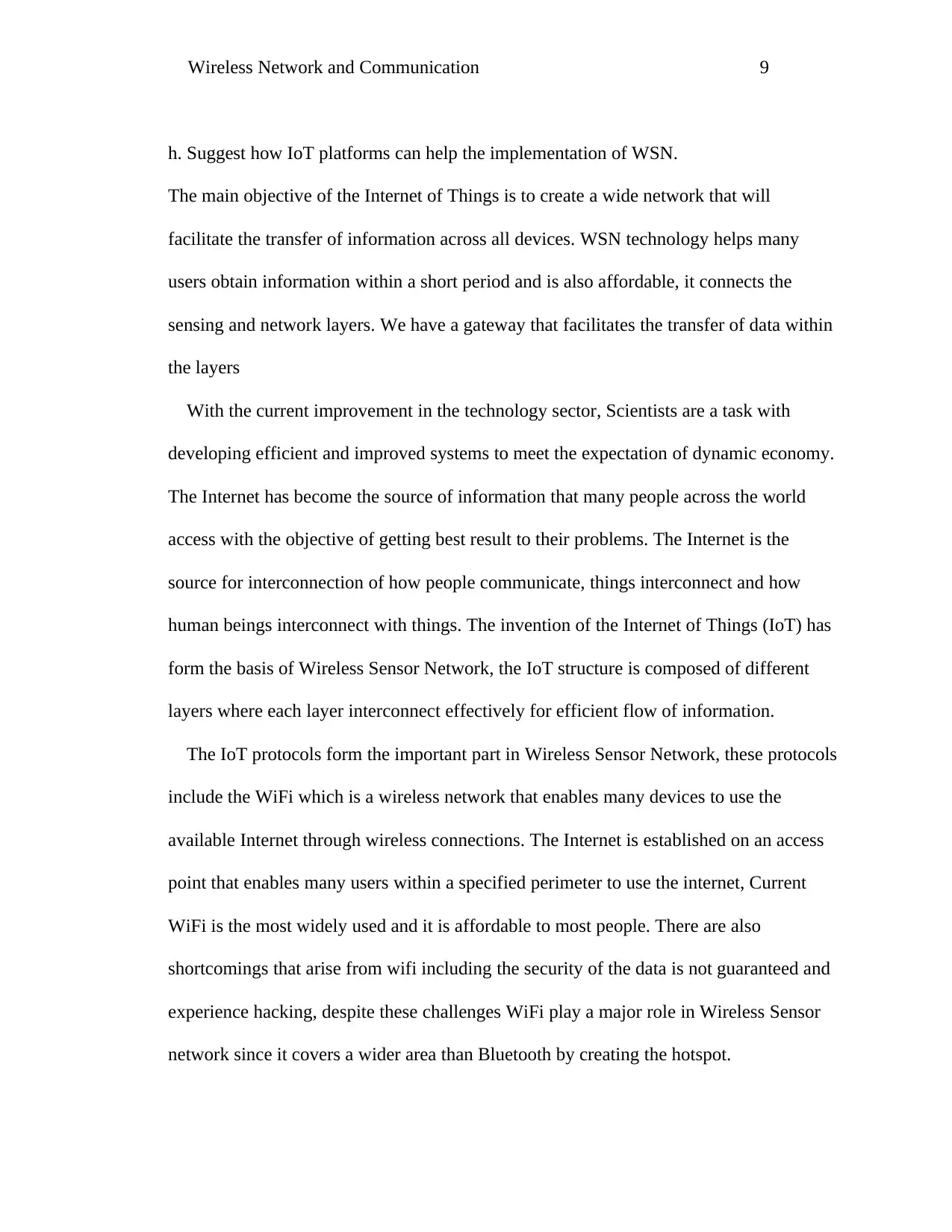
Wireless Network and Communication 9
h. Suggest how IoT platforms can help the implementation of WSN.
The main objective of the Internet of Things is to create a wide network that will
facilitate the transfer of information across all devices. WSN technology helps many
users obtain information within a short period and is also affordable, it connects the
sensing and network layers. We have a gateway that facilitates the transfer of data within
the layers
With the current improvement in the technology sector, Scientists are a task with
developing efficient and improved systems to meet the expectation of dynamic economy.
The Internet has become the source of information that many people across the world
access with the objective of getting best result to their problems. The Internet is the
source for interconnection of how people communicate, things interconnect and how
human beings interconnect with things. The invention of the Internet of Things (IoT) has
form the basis of Wireless Sensor Network, the IoT structure is composed of different
layers where each layer interconnect effectively for efficient flow of information.
The IoT protocols form the important part in Wireless Sensor Network, these protocols
include the WiFi which is a wireless network that enables many devices to use the
available Internet through wireless connections. The Internet is established on an access
point that enables many users within a specified perimeter to use the internet, Current
WiFi is the most widely used and it is affordable to most people. There are also
shortcomings that arise from wifi including the security of the data is not guaranteed and
experience hacking, despite these challenges WiFi play a major role in Wireless Sensor
network since it covers a wider area than Bluetooth by creating the hotspot.
h. Suggest how IoT platforms can help the implementation of WSN.
The main objective of the Internet of Things is to create a wide network that will
facilitate the transfer of information across all devices. WSN technology helps many
users obtain information within a short period and is also affordable, it connects the
sensing and network layers. We have a gateway that facilitates the transfer of data within
the layers
With the current improvement in the technology sector, Scientists are a task with
developing efficient and improved systems to meet the expectation of dynamic economy.
The Internet has become the source of information that many people across the world
access with the objective of getting best result to their problems. The Internet is the
source for interconnection of how people communicate, things interconnect and how
human beings interconnect with things. The invention of the Internet of Things (IoT) has
form the basis of Wireless Sensor Network, the IoT structure is composed of different
layers where each layer interconnect effectively for efficient flow of information.
The IoT protocols form the important part in Wireless Sensor Network, these protocols
include the WiFi which is a wireless network that enables many devices to use the
available Internet through wireless connections. The Internet is established on an access
point that enables many users within a specified perimeter to use the internet, Current
WiFi is the most widely used and it is affordable to most people. There are also
shortcomings that arise from wifi including the security of the data is not guaranteed and
experience hacking, despite these challenges WiFi play a major role in Wireless Sensor
network since it covers a wider area than Bluetooth by creating the hotspot.
⊘ This is a preview!⊘
Do you want full access?
Subscribe today to unlock all pages.

Trusted by 1+ million students worldwide
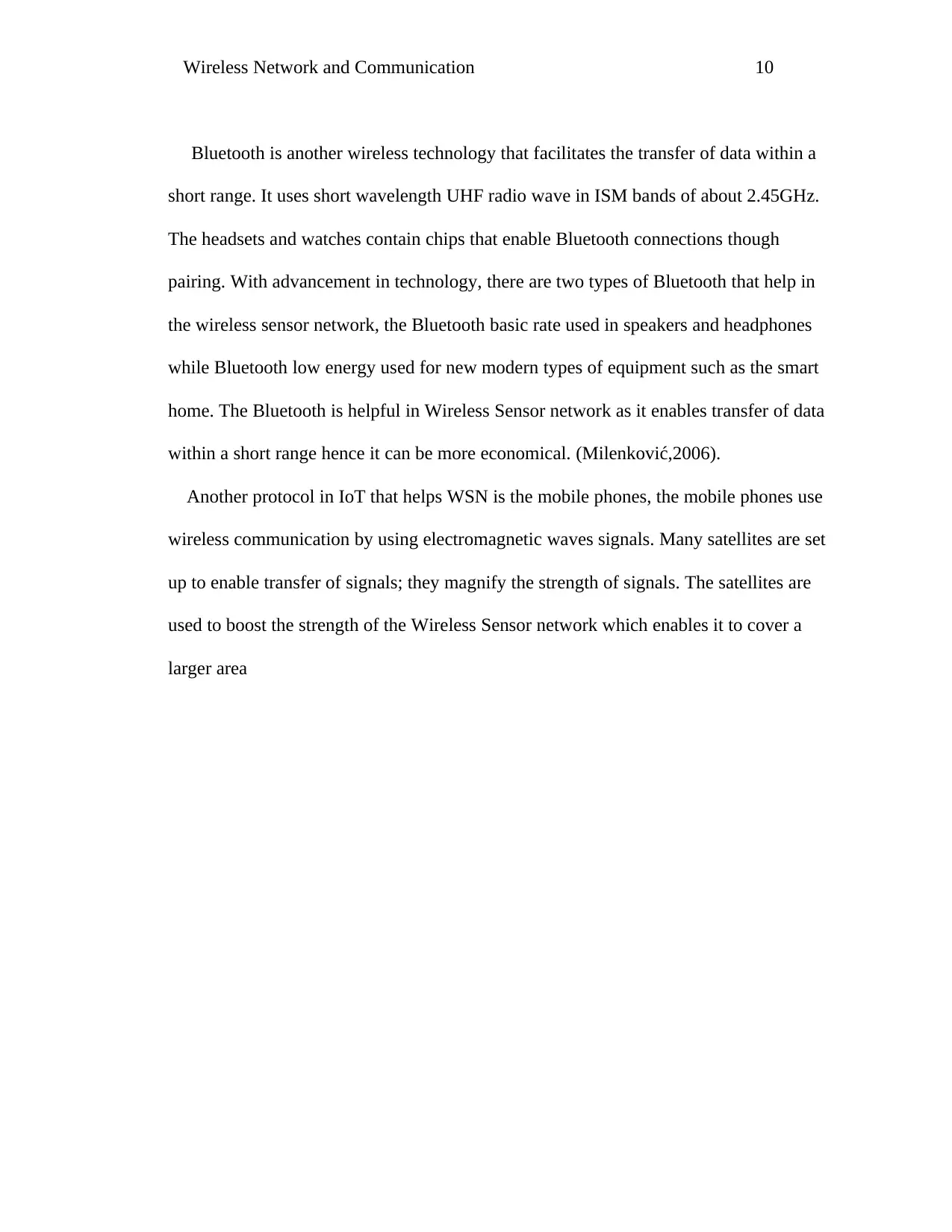
Wireless Network and Communication 10
Bluetooth is another wireless technology that facilitates the transfer of data within a
short range. It uses short wavelength UHF radio wave in ISM bands of about 2.45GHz.
The headsets and watches contain chips that enable Bluetooth connections though
pairing. With advancement in technology, there are two types of Bluetooth that help in
the wireless sensor network, the Bluetooth basic rate used in speakers and headphones
while Bluetooth low energy used for new modern types of equipment such as the smart
home. The Bluetooth is helpful in Wireless Sensor network as it enables transfer of data
within a short range hence it can be more economical. (Milenković,2006).
Another protocol in IoT that helps WSN is the mobile phones, the mobile phones use
wireless communication by using electromagnetic waves signals. Many satellites are set
up to enable transfer of signals; they magnify the strength of signals. The satellites are
used to boost the strength of the Wireless Sensor network which enables it to cover a
larger area
Bluetooth is another wireless technology that facilitates the transfer of data within a
short range. It uses short wavelength UHF radio wave in ISM bands of about 2.45GHz.
The headsets and watches contain chips that enable Bluetooth connections though
pairing. With advancement in technology, there are two types of Bluetooth that help in
the wireless sensor network, the Bluetooth basic rate used in speakers and headphones
while Bluetooth low energy used for new modern types of equipment such as the smart
home. The Bluetooth is helpful in Wireless Sensor network as it enables transfer of data
within a short range hence it can be more economical. (Milenković,2006).
Another protocol in IoT that helps WSN is the mobile phones, the mobile phones use
wireless communication by using electromagnetic waves signals. Many satellites are set
up to enable transfer of signals; they magnify the strength of signals. The satellites are
used to boost the strength of the Wireless Sensor network which enables it to cover a
larger area
Paraphrase This Document
Need a fresh take? Get an instant paraphrase of this document with our AI Paraphraser
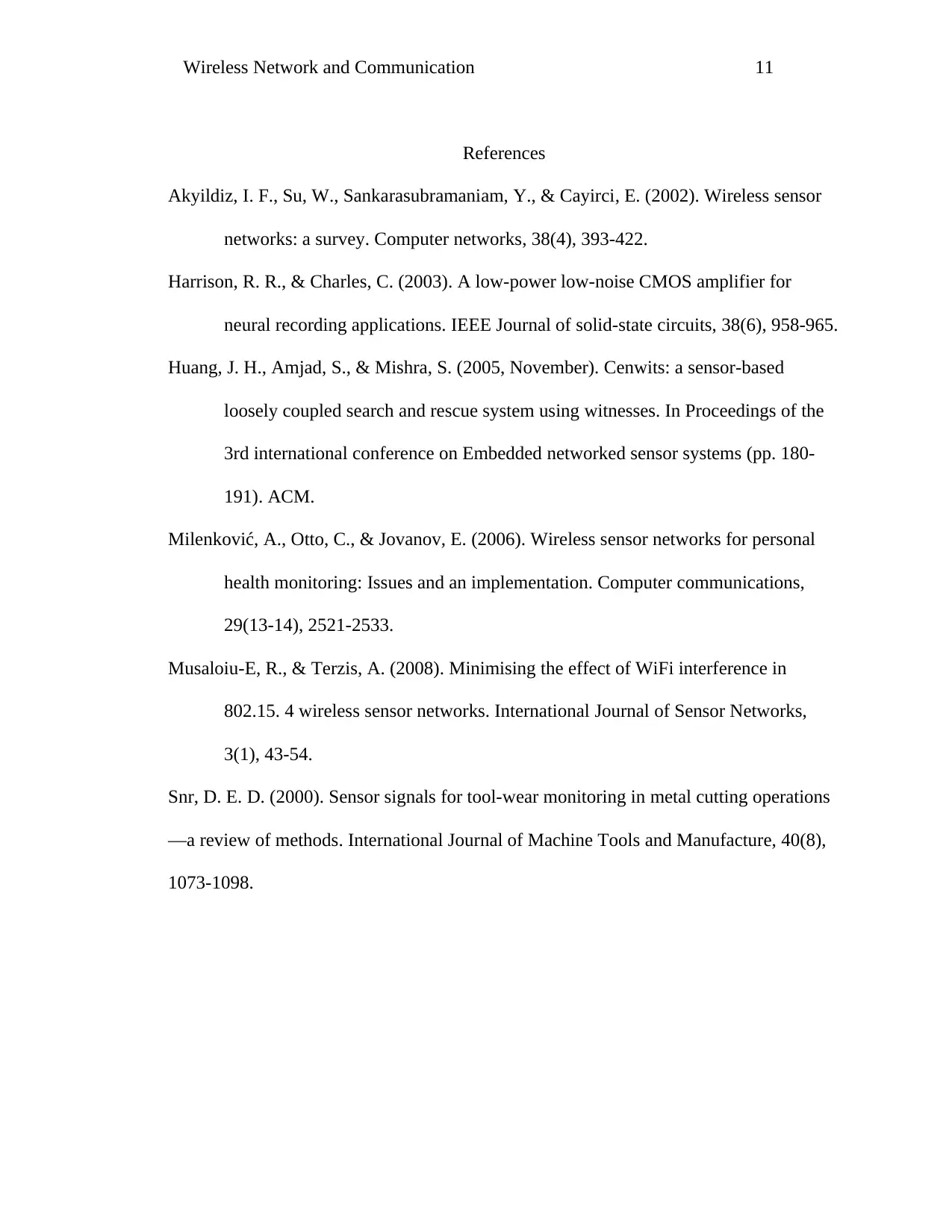
Wireless Network and Communication 11
References
Akyildiz, I. F., Su, W., Sankarasubramaniam, Y., & Cayirci, E. (2002). Wireless sensor
networks: a survey. Computer networks, 38(4), 393-422.
Harrison, R. R., & Charles, C. (2003). A low-power low-noise CMOS amplifier for
neural recording applications. IEEE Journal of solid-state circuits, 38(6), 958-965.
Huang, J. H., Amjad, S., & Mishra, S. (2005, November). Cenwits: a sensor-based
loosely coupled search and rescue system using witnesses. In Proceedings of the
3rd international conference on Embedded networked sensor systems (pp. 180-
191). ACM.
Milenković, A., Otto, C., & Jovanov, E. (2006). Wireless sensor networks for personal
health monitoring: Issues and an implementation. Computer communications,
29(13-14), 2521-2533.
Musaloiu-E, R., & Terzis, A. (2008). Minimising the effect of WiFi interference in
802.15. 4 wireless sensor networks. International Journal of Sensor Networks,
3(1), 43-54.
Snr, D. E. D. (2000). Sensor signals for tool-wear monitoring in metal cutting operations
—a review of methods. International Journal of Machine Tools and Manufacture, 40(8),
1073-1098.
References
Akyildiz, I. F., Su, W., Sankarasubramaniam, Y., & Cayirci, E. (2002). Wireless sensor
networks: a survey. Computer networks, 38(4), 393-422.
Harrison, R. R., & Charles, C. (2003). A low-power low-noise CMOS amplifier for
neural recording applications. IEEE Journal of solid-state circuits, 38(6), 958-965.
Huang, J. H., Amjad, S., & Mishra, S. (2005, November). Cenwits: a sensor-based
loosely coupled search and rescue system using witnesses. In Proceedings of the
3rd international conference on Embedded networked sensor systems (pp. 180-
191). ACM.
Milenković, A., Otto, C., & Jovanov, E. (2006). Wireless sensor networks for personal
health monitoring: Issues and an implementation. Computer communications,
29(13-14), 2521-2533.
Musaloiu-E, R., & Terzis, A. (2008). Minimising the effect of WiFi interference in
802.15. 4 wireless sensor networks. International Journal of Sensor Networks,
3(1), 43-54.
Snr, D. E. D. (2000). Sensor signals for tool-wear monitoring in metal cutting operations
—a review of methods. International Journal of Machine Tools and Manufacture, 40(8),
1073-1098.

Wireless Network and Communication 12
⊘ This is a preview!⊘
Do you want full access?
Subscribe today to unlock all pages.

Trusted by 1+ million students worldwide
1 out of 12
Your All-in-One AI-Powered Toolkit for Academic Success.
+13062052269
info@desklib.com
Available 24*7 on WhatsApp / Email
![[object Object]](/_next/static/media/star-bottom.7253800d.svg)
Unlock your academic potential
Copyright © 2020–2025 A2Z Services. All Rights Reserved. Developed and managed by ZUCOL.
